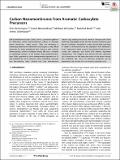Files in this item
Carbon nanomembranes from aromatic carboxylate precursors
Item metadata
| dc.contributor.author | Dementyev, Petr | |
| dc.contributor.author | Naberezhnyi, Daniil | |
| dc.contributor.author | Westphal, Michael | |
| dc.contributor.author | Buck, Manfred | |
| dc.contributor.author | Golzhauser, Armin | |
| dc.date.accessioned | 2020-04-28T15:30:01Z | |
| dc.date.available | 2020-04-28T15:30:01Z | |
| dc.date.issued | 2020-04-14 | |
| dc.identifier | 267667065 | |
| dc.identifier | 1931c607-4071-41b9-a834-c93f34936bf6 | |
| dc.identifier | 000525879700001 | |
| dc.identifier | 85083793004 | |
| dc.identifier.citation | Dementyev , P , Naberezhnyi , D , Westphal , M , Buck , M & Golzhauser , A 2020 , ' Carbon nanomembranes from aromatic carboxylate precursors ' , ChemPhysChem , vol. Early View . https://doi.org/10.1002/cphc.202000150 | en |
| dc.identifier.issn | 1439-4235 | |
| dc.identifier.other | ORCID: /0000-0003-1225-7607/work/73292956 | |
| dc.identifier.uri | https://hdl.handle.net/10023/19864 | |
| dc.description | P. D. thanks the “Fonds der Chemischen Industrie” for a Liebig Fellowship, the Royal Society of Chemistry for a Researcher Mobility Grant, and the “Max-Buchner-Forschungsstiftung” for a Max-Buchner Fellowship. This work was in part financed by the German Federal Ministry for Education and Research (BMBF) within the bilateral German-Greek Research and Innovation Cooperation, project Caerus 03XP0155 A. | en |
| dc.description.abstract | Self-assembled monolayers (SAMs) serve as convenient platform for fabricating carbon nanomembranes (CNMs) of extended lateral dimensions. Highly porous CNMs are emerging as interesting materials for membrane technologies as they exhibit selectivity for water permeation and, owing to their reduced dimensionality, promise increased energy efficiency compared to established systems. In the present study terphenylcarboxylate SAMs, prepared on silver underpotential deposited on Au and irradiated by 100 eV electrons, were successfully converted into free-standing CNMs. Infrared and X-ray photoelectron spectroscopy reveal pronounced chemical changes both of the anchoring carboxylate moiety and the aromatic backbone upon electron irradiation. Permeation studies showed high specificity for water as demonstrated by the separation from tetrahydrofuran. Compared to thiols on gold, the standard CNM precursor system, the carboxylic acid based SAM exhibits equivalent characteristics. This suggests that electron-induced carbonization is insensitive to the particular choice of the anchor moiety and, therefore, the choice of precursor molecules can be extended to the versatile class of aromatic carboxylic acids. | |
| dc.format.extent | 7 | |
| dc.format.extent | 1803420 | |
| dc.language.iso | eng | |
| dc.relation.ispartof | ChemPhysChem | en |
| dc.subject | Amorphous materials | en |
| dc.subject | Membranes | en |
| dc.subject | Self-assembly | en |
| dc.subject | Thin films | en |
| dc.subject | Vapor permeation | en |
| dc.subject | QD Chemistry | en |
| dc.subject | T-NDAS | en |
| dc.subject | SDG 7 - Affordable and Clean Energy | en |
| dc.subject.lcc | QD | en |
| dc.title | Carbon nanomembranes from aromatic carboxylate precursors | en |
| dc.type | Journal article | en |
| dc.contributor.institution | University of St Andrews. School of Chemistry | en |
| dc.contributor.institution | University of St Andrews. EaSTCHEM | en |
| dc.identifier.doi | 10.1002/cphc.202000150 | |
| dc.description.status | Peer reviewed | en |
This item appears in the following Collection(s)
Items in the St Andrews Research Repository are protected by copyright, with all rights reserved, unless otherwise indicated.

